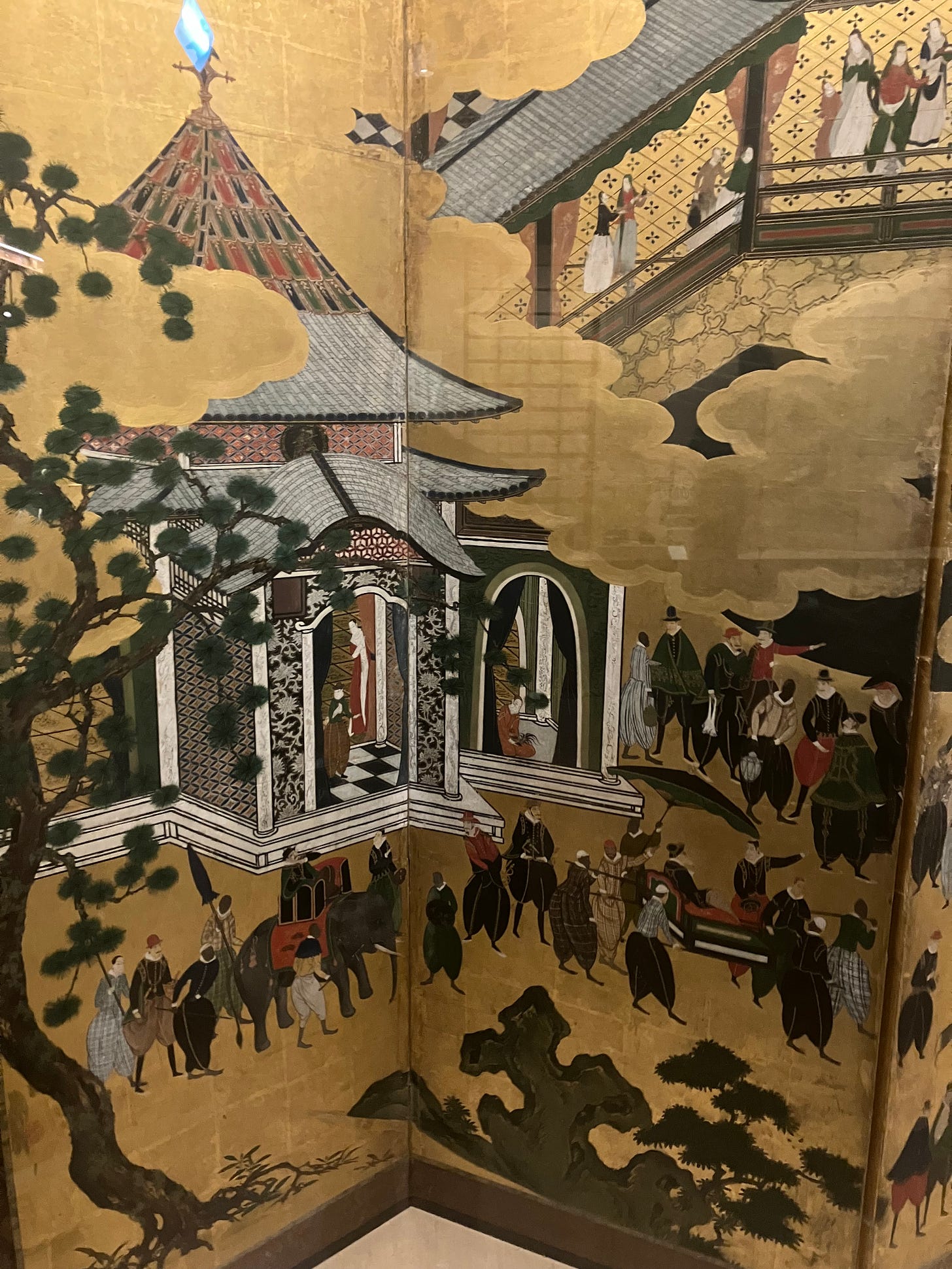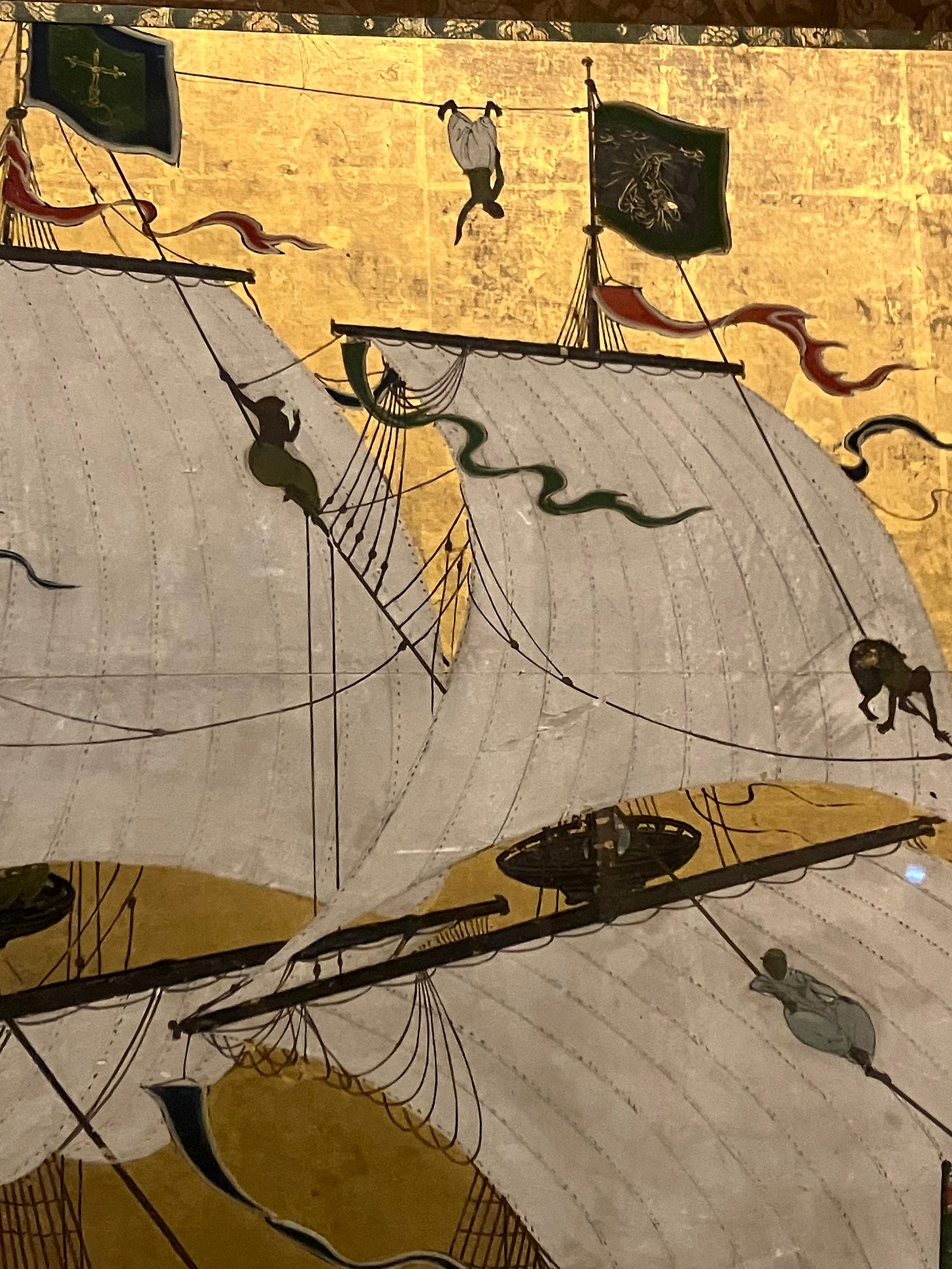1.
Phrases, like bits of music, surface in my mind from time to time. One of these recently playing on repeat as I've been walking around Lisbon has been Walter Benjamin's "There is no document of civilization that is not at the same time a document of barbarism.” In my usual feckless way (see my first post), my mind converted this Germanic negative phrasing into the catchier "Every document of civilization is also a document of barbarism." For those keeping score at home, the German is "Es ist niemals ein Dokument der Kultur, ohne zugleich ein solches der Barbarei zu sein." The shift in English from "Culture" to "Civilization" begs too many questions about the concept of civilization itself to be truly enlightening. Nevertheless, the translated version of the aphorism has been much cited in its afterlife, often lazily, by academic and public intellectual cultural historians and critics, becoming a kind of motto for our recent epoch of cultural reevaluation.
In its surface or common reading, Benjamin's sentence appears to urge us to look past or through the aesthetic content of various works of art, music, literature, architecture, etc. to see them as preserving evidence of the often brutal social and political conditions under which they were created, no matter how much these works might seem serenely to erase these traces. Works of art, in this way, become crime scenes, at best; Criticism a police procedural, exhuming the bodies buried in the cellars of the house of culture. At its most simplistic, art is then reduced to expressions of social realities—mere documents—and can be judged either "complicit" or "oppositional."
Those deemed complicit are now seen as unredeemably tainted, whether by barbarism of racism, colonialism, sexism, homophobia, fascism, or, more rarely, class discrimination. They are deacquisitioned from our cultural imaginary and removed from circulation.
However transformative it might once have been, Benjamin’s phrase has also suffered from this change. It has become cliché—a "One Way Street" with all the traffic going toward the barbarism latent in works of art and little or no attention paid to what Benjamin might have meant by "a document of civilization" or culture. Much in the same way, an earlier Belle-Lettristic era of criticism got itself caught up in another phrase with a similar structure, Keats's "Beauty is truth and truth beauty."
After reading Keats's “Ode on a Grecian Urn,” it's easy to be persuaded that the beautiful is a kind of truth, even if it's much harder for most of us to assent to the converse: that truth is always beautiful. With Benjamin, we can feel the force of "There is no document of civilization that is not at the same time a document of barbarism" without immediately questioning what might it mean to say that "There is no document of barbarism that is not at the same time a document of civilization."
2.
Like much of Benjamin's thinking, the aphorism of the “A is B” type derives from a philosophical framework in which neither civilization nor barbarism refer to absolutes or essences but denote tendencies in mutual tension. Similarly, when Benjamin's friend Adorno commented that "To write poetry after Auschwitz is barbaric," he was not intending to proscribe poetry or censor poets like some latter-day Plato. He was saying the valence of poetry had shifted. A spontaneous and life-affirming human practice that had previously been grouped among activities a person could do in a disciplined way so that they might feel cultured or civilized had been stripped of any morally or socially uplifting gloss.
You could still write poetry, just not give yourself airs while doing so. In fact you might want to feel somewhat ashamed, if, that is, you still harbored thoughts about being a civilized person.
3.
Benjamin’s phrase does work in reverse, though not in every instance. Documents of barbarism are also documents of potential civilization. The long description of the Pergamon altar frieze that opens Peter Weiss's novel "The Aesthetics of Resistance" neatly reveals both sides of this civilization and barbarism dialectic. The frieze had been carried off from Pergamon or Pergamum (present day Bergama) near Turkey's Aegean coast by German archaeologists in 1886; installed in Berlin, it was eventually housed in its own neo-classical museum completed in 1930. At the opening of Weiss's novel, in 1937, a group of young friends, all trying to articulate and sustain a meaningful opposition to the Nazi regime, are meeting at the museum. It's one of the few places they can safely gather.
Together and in dialogue, the friends observe the altar, which appears to be a classic instance of fascist aesthetics, and was indeed interpreted that way by the Nazis. The frieze depicts a legendary battle of the Greek gods against the Titans as well as the triumphs of the city's mythical founder, Telephus, a son of Herakles. The bodies are all in marbled classical proportions; the victors trample on the bodies of the fallen and lead some off to slavery: a martial culture's monument to its own success.
But even though, or precisely because the Pergamum altar appears to align perfectly with fascist militarism, its presence in Berlin in the 1930s allows it to serve as a site of resistance and resistant reading in the minds of Weiss's characters. Although the altarpiece was intended as a "winners’ history," the characters observe the bodies of the slaves; they wonder at the labor required to make this marble masterpiece and the conditions of those laborers in the quarries and workshops; they sense the seemingly crushing odds against them; feel the weight of the conqueror's boot on their own neck.
They also gain the knowledge that they are observing the ruins of an earlier empire, one that fell first to the Romans and then was buried undisturbed for centuries in what became a provincial backwater town under the Byzantine and then Ottoman empires. So even this apparent monument to an already-dated classical Greek ideal, appropriated to stand for a fascist ideal, once looked at from a certain angle begins to break down the barbaric structures underpinning it. Instead of judging it a piece of Hellenistic kitsch transformed into a piece of Fascist kitsch (at which point the thing might as well be blown up, or reburied, or graffitied over) understanding the frieze as a document of barbarism makes it once again available for a potential idea of civilization.
Original site of the Pergamon Altar, 2009, photo by author.
4.
Which brings me to my own recent encounter with one such ambiguous document of civilized-barbarism or barbarized-civilization, a pair of painted screens of the Kano school, from early 17th century Japan, purchased at auction in 1954 by the Museu Nacional de Arte Antigua in Lisbon, where they are currently exhibited.
These amazing painted screens, lacquered and layered in gold leaf and copper, depict, in loving detail, a significant historical event that occurred sixty years before their fabrication: the formal arrival of Portuguese trading ships to the port of Nagasaki sometime in the second half of the 1540s. (The first recorded contact between the two cultures occurred in 1543, when a Portuguese ship was wrecked on Tanegashima island.)
Displayed here is the entire panoply of Portuguese mercantile-imperial pomp—chests of goods carried by slaves, barrels rolled by slaves, a slave holding a parasol for a group of seated merchants, lanterns of Islamic design, horses led by slaves, European hunting dogs, perhaps gold in black bags carried on a trays, even an elephant. The Japanese peer at them from open entrances of houses along the route, or looking down on them from balconies. But what makes these so-called "Nanban screens" (Nanban, I'm told, is the Japanese word for barbarian, which is what they called the Portuguese.) so remarkable is the sheer sense of wonder they communicate.
You can see the curiosity in people's faces and gestures—the geisha half-revealed, parting a curtain, a number of children turn up with expressions ranging from open-mouthed delight to eyebrow-raising skepticism. The adults look on either with a detachment that could almost be called "irony," or explicit greed. In the rigging of the enormous black ship sailors hang upside down from their knees, lounge in the sails as if at ease in hammocks, or climb like tight-rope walkers, adding to this circus-like or celebratory atmosphere, presided over by these strange pointy-nosed, fox-like folk with their baggy pantaloons and chimney pot hats.
There is nothing here to suggest anyone was aware they were chronicling a cultural collision.
There's no evidence, for instance, of the matchlock muskets that the Portuguese sold, or the cannons on the ships. These would transform Japanese martial culture, and, in the short term, the guns would prove instrumental in ending the stalemated feudal wars that had wracked 16th century Japan.
Neither could anyone involved in making or commissioning these screens have had any idea that they were recording the Japanese entrance into Western European modernity, an encounter which would lead to Pearl Harbor, and—400 years from the events portrayed in the screens—the dropping of an atomic bomb on the same port city where the Portuguese and later Dutch ships had landed. These later events too are part of the history that enables me, as an American and a Jew of Eastern European ancestry, to stand before them in 2024.
No one appears to be suffering, even in the background. To minds trained to regard the barbarism inside the civilization, the whole ethos of the screens comes as a shock. This is Breughel's "Great Kermess" without the fall Icarus. Colonialism is not supposed to look like this, not through the eyes of the colonized. Either these old masters were wrong about suffering, or they know something we don’t. The Japanese didn't think of themselves in this way. They made the screens, and the screens record a magical gift exchange between equal partners.
Partial view of Nanban Screen, photo by author, courtesy of Museu Nacional de Arte Antiga, Lisbon.
5.
The presence of these screens in a Portuguese museum adds another layer to the story. Unlike the Pergamon altar frieze in Berlin, the screens aren't particularly celebrated features of the collection. Their role in contemporary Portugal’s political and cultural imagination feels marginal, uncertain. They aren’t quite hidden, but I would never have seen them if it hadn't been for a friend who all but ordered me to visit them, even giving directions to their home—a dim, quiet corner of a wing completed the same year the late Weimar Republic finished its exultant Pergamon museum. They live there suspended—in serene museal neglect—amid a much larger collection from Portugal's colonial encounters of varying quality and importance. Delicate Goan ivory inlaid furniture and box-work, a nativity scene influenced by Hindu temple sculpture, and a remarkable glass screen Macau Madonna are displayed alongside cases and cases of ceramics and lacquer and teak— as if in any commercial warehouse. It’s a fitting context for the fruits of the world's first globalizers.
This also comes as a relief to the American museum-goer who has become used to exhibitions draped with wall text designed to situate both objects and spectators in a moral context in which the arc of art history is long but bends toward justice. In this other minimally curated space—a result, I’m told of the museum’s descent into ragged genteel poverty—the objects float freed from our era’s own civilizing demands. They whisper that—if we are fortunate in our lives—sometimes the layers of the matrix fall away—We behold and are beheld, if only for a frozen moment, with wonder and with hope. —F.B.
(If you enjoyed this document of civilized barbarism, or barbarized civilization, kindly consider subscribing or upgrading your current free subscription.)






